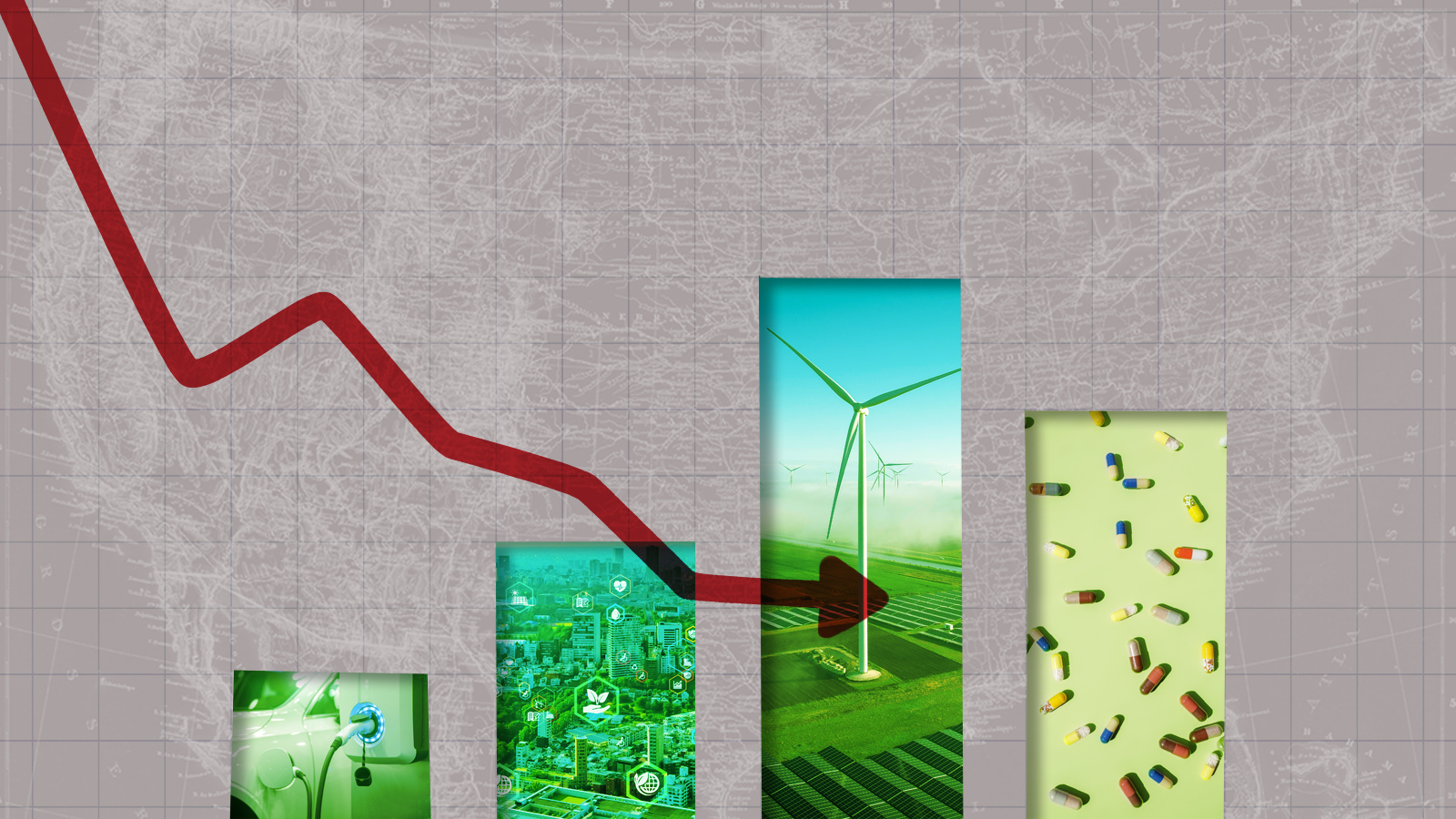6 ways the Inflation Reduction Act changed America and the world in 1 year
Biden's massive green energy and industrialization law has accomplished a lot in a short time, but its future is up in the air


President Biden and members of his Cabinet are fanning out across the U.S. to talk about the Inflation Reduction Act on the first anniversary of its passage.
This is partly a celebration tour for the largest piece of climate-stabilizing legislation ever enacted in the U.S., but it's also a public relations exercise: Some Americans recall the drama around getting Sen. Joe Manchin (D-W.Va.) and then Sen. Kyrsten Sinema (I-Ariz.) to support the massive environmental, health care, energy and industrial policy bill, but many fewer have followed what happened after Biden dragged it across the finish line.
Only 27% of Americans said they knew a great deal or good amount about the IRA in a July 13-23 Washington Post/University of Maryland poll, while 71% said they knew little or nothing about the law. That's pretty common with big laws, Ezra Klein said at The New York Times. "There is all this attention to the fight to pass a bill — the Affordable Care Act, the Trump tax cuts, the Inflation Reduction Act. And then the bill passes. And if the fight stops, attention just drops off a cliff."
The Week
Escape your echo chamber. Get the facts behind the news, plus analysis from multiple perspectives.

Sign up for The Week's Free Newsletters
From our morning news briefing to a weekly Good News Newsletter, get the best of The Week delivered directly to your inbox.
From our morning news briefing to a weekly Good News Newsletter, get the best of The Week delivered directly to your inbox.
But while attention has been elsewhere, quite a bit has happened with the IRA since Biden signed it into law on Aug. 16, 2022.
The law has capped insulin prices and out-of-pocket drug expenses for Medicare beneficiaries and beefed up corporate and high-income tax compliance, but the IRA's biggest goal is "to spur clean energy buildout on a scale that will bend the arc of U.S. greenhouse gas emissions," using components made in America, The Associated Press reported. "In less than a year it has prompted investment in a massive buildout of battery and EV manufacturing across the states."
"The green energy portion of the bill" — already slated to be "the most aggressive effort to decarbonize the U.S. economy ever" — is "turning out to be even bigger than analysts thought at the time," Rick Newman wrote at Yahoo Finance. In fact, "the laughably misnamed and poorly understood Inflation Reduction Act" may end up being "the biggest sleeper event of the Biden presidency." Here are some ways the IRA has changed America, and the world, after one year.
1. Cut carbon emissions
The U.S. pledged in the 2015 Paris Agreement to slash greenhouse gas emissions by half of 2005 levels before 2030. Former President Donald Trump withdrew the U.S. from the agreement two years later, and by the start of the Biden administration, analysts at Rhodium Group, an independent analytics firm, forecast that the U.S. would, at best, cut emissions by about a quarter.
A free daily email with the biggest news stories of the day – and the best features from TheWeek.com
Thanks largely to the IRA, Rhodium said in its July 2023 report, the U.S. is on track to cut emissions by as much as 42% by 2030 and by 32% to 51% by 2035. That's "a meaningful departure from previous years' expectations for the U.S. emissions trajectory," Rhodium analysts wrote.
Other analyses reached similar conclusions. A study by Princeton University researchers forecast that the IRA would cut U.S. greenhouse gas emissions by 41% by 2030. A group of academic and private-sector energy researchers reported in the journal Science in June 2023 that thanks to "key IRA provisions," there should be "economy-wide emissions reductions between 43% and 48% below 2005 levels by 2035."
None of those projections are "enough to hit U.S. goals," AP notes, but they're certainly "a significant improvement."
2. Charged the electric vehicle market
The best data we have that the IRA is working is with electric vehicles (EVs), Heatmap's Robinson Meyer said on The Ezra Klein Show podcast. The law seeks "to both encourage Americans to buy and use electric vehicles and then also to build a domestic manufacturing base for electric vehicles. And I think on both counts, the data's really good on electric vehicles."
The IRA offers consumers tax credits of up to $7,500 for new electric vehicles that are priced affordably and substantially made in the U.S., and up to $4,000 for used EVs. Sales of electric vehicles rose 53% in the first quarter of 2023, compared with a year earlier, and EVs "now make up one in every 12 cars sold" in the U.S., the investment firm Schroders reported.
Rhodium forecast that EVs could make up 33-66% of all light-duty vehicle sales in 2035, from about 6% in 2022. "Though there's uncertainty on just how fast the U.S. scales up renewable energy on the grid or EVs on the road, those levels of deployment would be meaningfully lower than what we're estimating in our modeling under otherwise the same conditions absent the IRA," Ben King, lead author of the Rhodium report, told Grist.
On the production side, "steel's going in the ground" on electric vehicle and EV battery factories, Meyer said. "The financing for those factories is locked down. It seems like they're definitely going to happen. They're permitted. Companies are excited about them. Large Fortune 500 automakers are confidently and with certainty planning for an electric vehicle future, and they're building the factories to do that in the United States," in both red and blue states.
Since the IRA became law, "companies have announced at least 31 new battery manufacturing projects in the United States," former Biden White House economic adviser Brian Deese wrote in The New York Times, creating a pipeline that "amounts to 1,000 gigawatt-hours per year by 2030 — 18 times the energy storage capacity in 2021, enough to support the manufacture of 10 million to 13 million electric vehicles per year."
The U.S. battery production pipeline is now growing faster than in Europe or even China, Schroders added. "The incentives from the IRA have been so strong that corporates have been reallocating capital spend from Europe to the U.S."
3. Ramped up U.S. manufacturing
It's not just battery plants — about 80 clean energy manufacturing facilities have been announced since the IRA became law, "an investment equal to the previous seven years combined," AP reported, citing the American Clean Power Association.
"It seems like every week there's a new factory facility somewhere" being announced, Jesse Jenkins, a professor at Princeton who has closely analyzed the IRA, told AP. "We've been talking about bringing manufacturing jobs back to America for my entire life. We're finally doing it, right? That's pretty exciting."
"We will always look at the history of our industry in two eras now that the Inflation Reduction Act has passed," the before era and afterward, Scott Moskowitz at solar panel component manufacturer Qcells North America told the Times. "The IRA contains some of the most ambitious clean energy manufacturing incentives enacted anywhere in the world."
The IRA also has the U.S. "building transmission lines and green hydrogen manufacturing facilities and trying to create a national network of electric vehicle chargers and on and on and on," Klein said on his podcast. "I mean, we're trying to do industrial physical transformation at a speed and scale unheralded in American history. This is bigger than anything we have done at this speed ever."
4. Helps homeowners and renters go electric
The IRA "is the largest clean energy investment America has ever made, with strategic incentives to make the transition to clean energy and a decarbonized life easy and financially smart," but it's also "full of incentives to help you and your family go electric," the electrification nonprofit Rewiring America said. In fact, you can "think of the IRA as a free electric bank account with your name on it, because that's what it is."
The IRA has two main consumer-oriented programs, the Home Efficiency Rebates program and the Home Electrification and Appliance Rebates program. And households can access up to $14,000 or more to install heat pumps, insulation, solar panels, EV hookups, or energy-efficient appliances, depending on your household income, cost of your project, total energy savings — and whether your governor signs on, Greg Iacurci reported at CNBC.
Already, "one state, Florida, has publicly signaled it doesn't intend to apply for its $346 million of allocated federal funds," and "it's unclear if other states will bow out as well," Iacurci said. If they do, their money will be allocated to states that opt in. The rebates, designed to be delivered at the point of sale from a retailer or contractor, should be available in late 2023 or 2024, the Energy Department estimates.
Rewiring America has a list of the various rebates and upfront discounts — and an "IRA savings calculator" to help you figure out which ones you might qualify for, and at what amount.
5. Aims to build a green hydrogen market from scratch
The IRA's most generous subsidies involve hydrogen — "blue hydrogen," which is made from natural gas and envisioned as a way to capture and store carbon, and "green hydrogen," which is "produced by using clean energy, such as solar or wind power, to split water into two hydrogen atoms and one oxygen atom through a process called electrolysis," Schroders explained. "The IRA has introduced extremely generous subsidies for hydrogen, particularly for green hydrogen."
The IRA subsidies for green hydrogen, which will be used as a fuel especially in industries that can't easily electrify, "are so generous that relatively immediately, it's going to have a negative cost to make green hydrogen. It will cost less than $0 to make green hydrogen," Heatmap's Meyer told the Times. "That is intentional because what needs to happen now is that green hydrogen moves into places where we're using natural gas," and right now there's no clean hydrogen economy set up to make that happen at scale.
Green hydrogen is "one of these technologies on the cusp," Klein agreed, and the IRA hopes to "create a whole innovation and supply chain almost from scratch." Work on larger-scale projects has gotten off to a slow start, but "we are optimistic that progress will pick up in the latter half of the decade as electrolyser technology is further developed and proven," Schroders said.
Jason Mortimer at EH2, which makes large and low-cost electrolyzers, told AP that "the IRA accelerates the implementation of hydrogen at scale by about four to five years," making the U.S. competitive with Europe.
6. Spurred allies and rivals to step up their efforts
As much as they support decarbonization efforts, "nations in Europe and elsewhere are rattled by the possibility that the United States might now capture an outsized portion of the global green energy economy, and some are planning muscular incentives of their own to stimulate home-grown technology," Yahoo Finance's Newman wrote. On the plus side, "that could create a race to solve the problem, if only to capture the economic benefits."
On the negative side, "many of the U.S.'s allies like Japan, Canada, and especially the European Union," see the IRA "less as long-awaited efforts to finally make good on promises of climate action and more as a threat to the ability of places like Europe to attract investment themselves," Alex Yablon said at Vox. "At the moment Biden wanted the transatlantic democratic alliance to come together for a common purpose and approach, wonks on either side of the ocean are sniping at each other."
This isn't a winner-takes-all race, but the U.S. clearly has to work with global partners "to build a cooperative international framework around the IRA's investment incentives" and "build resilient energy supply chains, particularly for critical minerals," Deese wrote at the Times. "Our allies have little to fear and much to gain from working with the United States to expand incentives domestically to deploy clean energy technology because it must be deployed everywhere, and the IRA incentives will drive down the global cost of energy technologies" for everyone.
The Inflation Reduction Act, at one year old, is still in its infancy, and much about how it changes the economy and environment are unknown — and unknowable. Some of the bets the government and industry are making could fail, or they could pay off wildly above expectations. Skeptical state and local governments could limit the law's efficacy. A future Republican president could try to undo key provisions. Permitting delays could thwart projects or delay their benefits.
But decarbonizing the economy is an existential imperative, and time isn't on our side. "If the U.S. can start cutting down the emissions, steadily year over year, decade over decade, then we are on the right path to limit global warming," Aiguo Dai, a professor of atmospheric and environmental science at the University of Albany, told NPR News. "If we cut it too [slowly], it could be difficult to avoid catastrophic warming in the near future."
Peter has worked as a news and culture writer and editor at The Week since the site's launch in 2008. He covers politics, world affairs, religion and cultural currents. His journalism career began as a copy editor at a financial newswire and has included editorial positions at The New York Times Magazine, Facts on File, and Oregon State University.
-
 Trump aims to take down ‘global mothership’ of climate science
Trump aims to take down ‘global mothership’ of climate scienceIN THE SPOTLIGHT By moving to dismantle Colorado’s National Center for Atmospheric Research, the White House says it is targeting ‘climate alarmism’
-
 The powerful names in the Epstein emails
The powerful names in the Epstein emailsIn Depth People from a former Harvard president to a noted linguist were mentioned
-
 Donald Trump and Jeffrey Epstein: a Timeline
Donald Trump and Jeffrey Epstein: a TimelineIN DEPTH The alleged relationship between deceased sex trafficker Jeffrey Epstein and Donald Trump has become one of the most acute threats to the president’s power
-
 ‘It’s ironic in so many ways’
‘It’s ironic in so many ways’Instant Opinion Opinion, comment and editorials of the day
-
 Newsom slams Trump’s climate denial at COP30
Newsom slams Trump’s climate denial at COP30speed read Trump, who has called climate change a ‘hoax,’ declined to send any officials to this week’s summit
-
 Alaska faces earth-shaking loss as seismic monitoring stations shutter
Alaska faces earth-shaking loss as seismic monitoring stations shutterIN THE SPOTLIGHT NOAA cuts have left the western seaboard without a crucial resource to measure, understand and predict tsunamis
-
 ‘Security is no longer a function only of missiles and fighter jets’
‘Security is no longer a function only of missiles and fighter jets’Instant Opinion Opinion, comment and editorials of the day
-
 ‘This is where adaptation enters’
‘This is where adaptation enters’Instant Opinion Opinion, comment and editorials of the day


